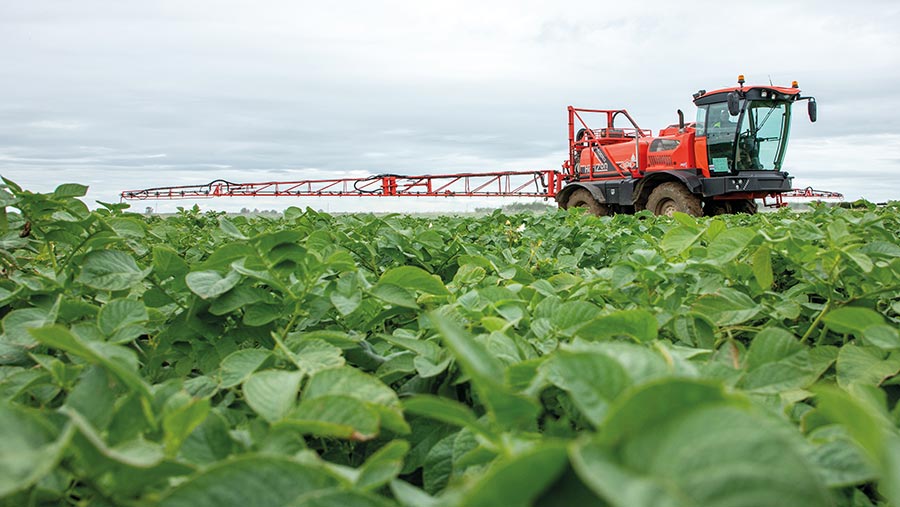What a new fungicide-resistant blight strain means for UK farmers
 © Gary Naylor
© Gary Naylor The discovery of the first strain of potato blight that is resistant to a carboxylic acid amide fungicide has highlighted the need to use mixes and alternate between different ones in 2023 spray programmes.
One Scottish expert says it also underlines the need for near-market research such as the Fight Against Blight campaign, which has an uncertain future after the AHDB withdrawing from the potato sector.
See also: 4 steps to tackle potato cyst nematodes after granular nematicides
On 6 January 2023, researchers from the University of Aarhus in Denmark released the results of a study on the disease.
It shows that five geographically diverse isolates sampled from Danish crops in 2022 and belonging to the genotype named EU_43_A1 were completely resistant to mandipropamid.
EU_43_A1 was first identified in Denmark in 2018 and subsequently accounted for 21% of samples in 2021 and 45% of samples in 2022.
Last year, it was also detected in the Netherlands and Belgium. And it is expected to spread to the UK.
So what does this mean for UK potato growers this season?
Mandipropamid, the active substance contained in Revus, is a member of the carboxylic acid amides (CAA) group, which also contains other actives used for protection against late blight.
Cross-resistance
EU_43_A1 is the first strain of blight reported to have resistance to a CAA fungicide. Cross-resistance to others in the CAA fungicides group is likely, including dimethomorph, benthiavalicarb and valifenalate.
This means that the finding has a bearing on 50% of fungicides used in a typical late blight programme during the season.
Eric Anderson, senior agronomist at Scottish Agronomy, says that while actives with different modes of action are still fully effective against late blight, it is critical that the over-reliance on a single substance does not exacerbate the likelihood of resistance developing to the remaining fungicides.
“Mixes of products from different mode of action groups are essential to protect crops and preserve the efficacy of these products for future seasons. Alternation between mixes is equally essential to prevent resistance developing.”
Fungicide advice
Therefore, alternation and mixtures are required to be able to prevent and fight late blight and at the same time maintain the effect of the remaining modes of action.
For this reason, Mr Anderson says growers should avoid using products such as Shirlan, Ranman Top, Revus or Carial Flex without inclusion of another at an effective dose and belonging to an alternative mode of action.
Actives
- Shirlan – fluazinam
- Ranman Top – cyazofamid
- Revus – mandipropamid
- Carial Flex – cymoxanil + mandipropamid
Mr Anderson says while it’s not surprising that the new resistant strain should first occur in Denmark given the limited products available to farmers, there are lessons still to be learned.
“It’s a basic principle of integrated strategies that products containing only a single mode of action should be mixed before application to reduce the risks of resistance and preserve efficacy for future years.”
Mr Anderson says that UK growers are fortunate to have enough products to alternate between applications.
“In Denmark, there are fewer actives approved for late blight protection in potatoes, so it is perhaps not surprising that resistance has been detected to one,” he says.
“It should serve as a warning to other growers of the risks that come when we apply selection pressure by over reliance on single products.”
He says the latest case is an exact repeat of what happened with fluazinam in 2016 and is another reason why near-market research of the sort undertaken by the Fight Against Blight is vital to sustaining the economic viability of the sector.
Fight against blight
Last season, the work by researchers at the James Hutton Institute continued thanks to funding from the Scottish government for the Fight Against Blight campaign.
But its future remains uncertain following the end of AHDB Potatoes operations last year.
Data from the ‘s Pesticide Usage Survey for 2020 – the last year in which potatoes were surveyed – reveals that almost 29,000kg of mandipropamid was applied.
This compares with nearly 25,000kg of cyazofamid, another widely used active substance valued for its role in the rapid crop canopy phase of the season and when crops need protecting against tuber blight.

